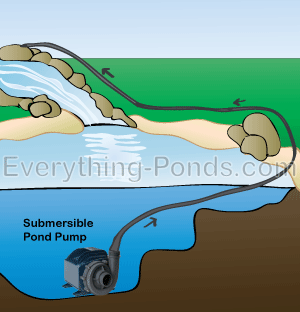WHEN TO USE A SUBMERSIBLE POND PUMP
When deciding on a pump for a pond project, you can choose either a submersible pond pump or an external pump. As you may have guessed, a submersible pump is installed and operated beneath the surface of the pond, while an external pump sits outside of the pond in a dry location.
TO VIEW ALL OUR PUMPS FOR SALE, PLEASE VISIT OUR POND PUMPS PAGE.
Both systems have certain strengths and weaknesses that you'll need to consider before deciding which system is right for your particular project. Whichever system you choose, make sure to purchase a good quality, reliable pump that can be trusted to run 24/7, 365 days a year. Since the pump drives the main filtration system in your pond, a healthy pond ecosystem depends on the pump's continued, reliable operation.
How Pond Pumps Work
Submersible pond pumps operate on a fairly basic principle when broken down. An electric motor is used to drive an impeller. As the impeller turns, water is drawn in on one side of the pump and expelled out the other. The amount of water flow is determined by the power and size of the impeller. The larger the impeller, the more water can be pumped. Of course, as the impeller gets larger, a more powerful electric motor is also required, which in turn uses more electricity.
Why Use a Submersible Pond Pump
There are a few advantages that submersible pond pumps have over external varieties. The first is that, because submersible pumps are kept submerged in water, no priming is necessary. With external pumps, care must be taken to ensure there is water in the pipes before turning on the pump to prevent it from sucking in air. If there's any air in the system, no water will be pumped in most cases. Another advantage of submersible pumps is their ease of concealment in a pond, due to the pump being stored under the water. In the case of an external pump, a little extra effort is required to hide the pump somewhere in the landscaping while keeping it accessible for maintenance.
Limitations of Submersible Pond Pumps
Sometimes, if a pump needs to be placed in an area with limited size or clearance, fitting an entire submersible pump may be difficult. In these situations, it is much easier to place an intake pipe, which is much smaller than the pump itself, leading to an external pump. An example of such a situation would be a skimmer. To get water flowing through the skimmer to capture floating debris, some kind of pump is needed inside the skimmer to draw water in. If the skimmer is large enough, you can place a submersible pump directly inside it. However, if the pump is too large or the skimmer is too small, then an external pump may be necessary. To learn more, please see our page on external pond pumps.
How Large a Pump is Needed?
Whether you decide to go with a submersible pond pump or not, you will still need to determine how much water is in your pond to purchase an appropriately sized pump. As a minimum, your pump should be capable of pumping the entire contents of your pond in two hours. If you plan on adding koi or another type of fish to your pond, turning over the contents of your pond more frequently, such as every hour, is advisable. Also, bear in mind that pump flow rates are measured assuming there is no extra strain on the pump due to gravity or pipe fittings. In cases where you are pumping water uphill (e.g., for a waterfall), you will need to take this additional 'head pressure' into account. For more information on calculating the head pressure in your pond, please see our page on Calculating Pond Head Pressure.
Click Here to Return from Submersible Pond Pump to Pond Pumps
Click Here to Return from Submersible Pond Pumps to our Home Page


